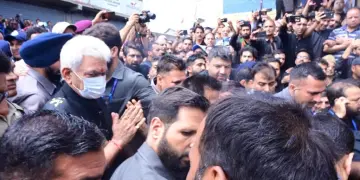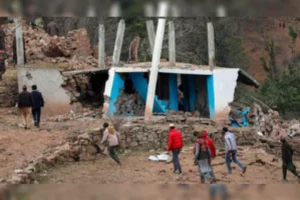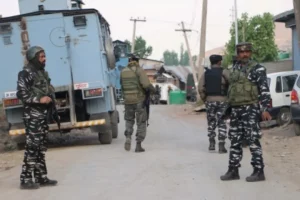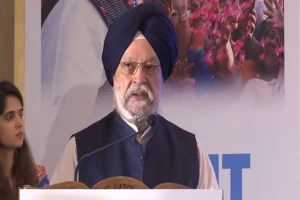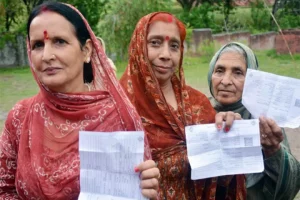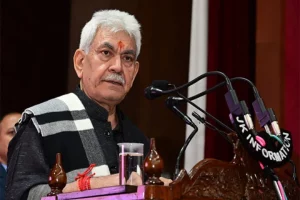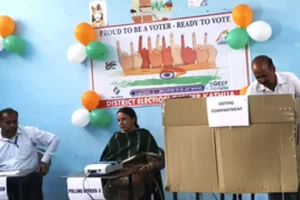(In the first part of the article, our Srinagar correspondent Ahmed Ali Fayyaz had highlighted how anti-national forces were allowed to grow under Congress and the PDP governments as part of political expediency in the years prior to 2014. )
In March 2015—July 2016, Burhan Wani found Kashmir as the most fertile land to revive insurgency. It was the period when most of the FIRs were registered against the Army and the paramilitary personnel for ‘resorting to excessive force’ and other ‘human rights abuse’; when most of the counterterror operations failed due to stone pelting and mob attacks on the forces; when funeral processions and gun salutes to the terrorists killed in encounters became a routine.
The sports stadiums, where Government of India’s ‘Khelo India’ games were played, were named after Burhan Wani. His father, a government school teacher, used to be the chief guest at the inauguration of local sports tournaments. For the first time after 1988, local Kashmiri militants removed their face masks and published their pictures and videos on Facebook and YouTube.
Even after Burwan Wani announced through a video in August 2015 that he was fighting for establishing an Islamic State in Kashmir, he continued to be on the forefront of the valley’s separatist movement. Stalwarts like Syed Ali Geelani began claiming credit for Wani’s secret association with them. Funeral processions and gun salutes, coupled with registration of FIRs against the security forces, encouraged hundreds of the valley’s youths to pick guns and stones against anything Indian.
In November 2015, over 7,000 people participated in each of two militants’ funerals around Bijbehara, then Chief Minister Mufti Mohammad Sayeed’s hometown. Two months later when Mufti died, the crowd in his funeral procession was less than 1,500. Not a single shop was shut in Bijbehara.
Mufti’s funeral made it clear that he had successfully razed the National Conference’s fortress but the vacuum was being filled up by Geelani and his Pakistan-supporters, not Mufti’s PDP. Mufti and his Ministers did an abject surrender when the Opposition sought clarification regarding the BJP-PDP government’s plan to settle the Kashmiri Pandit migrants at some secured camps. It failed the BJP-led Centre’s plans of relief and rehabilitation for the displaced population.
Notwithstanding the counterinsurgency operations by the security forces, militants, separatists and their well-wishers in the institutions of politics and governance enjoyed a field day in 2016. By the time Burhan Wani died in an encounter on 8 July 2016, the entire valley was on a powder keg. Chief Minister Mehbooba Mufti said publicly that if she would have been informed about Wani’s presence at the hideout in Kokernag, she would have withdrawn the troops and let the militant escape.
During the four months after Wani’s death, Kashmir witnessed its worst ever street turbulence, arson and clashes with security forces. Over 2 lakh people were allowed to participate
in Wani’s funeral at Tral. The separatists held massive rallies for Wani. It led to a near-total breakdown of the police and administrative machinery. Over a hundred died in clashes with security forces. More than 8,000 civilians and 4,000 police and paramilitary personnel sustained injuries in these clashes. Pakistani flags were raised across the valley from Uri and Kupwara to Bhaderwah and Rajouri.
More than 18,000 civilian and government vehicles were damaged in stone pelting for violating Geelani’s unceasing hartal calendar. Unruly youths on streets beat up policemen and government employees. Women commuters were checked on streets to verify if they were really pregnant and going to a doctor.
On the other hand, the Chief Minister repeatedly declined Delhi’s signal to hold the overdue Panchayat and municipal elections. This was the period when some of the top separatists and militant leaders managed the entry of their kith and kin into the government services through the back door. All rules were violated in the appeasement of some top pro-Pakistan leaders including Geelani.
As the separatists and militants kept gaining ground in their most conducive atmosphere, Pakistan virtually seemed to be a partner in the Government that erased everything Indian in Kashmir. Cricket tournaments began starting with the Pakistani national anthem. The militants, separatists and their entire ecosystem dominated the social media while trolling, abusing and threatening every pro-Indian voice.
Finally, journalist Shujaat Bukhari’s broad daylight assassination by terrorists in Srinagar’s Press Enclave came literally as the last nail in the coalition’s coffin. Within four days, BJP withdrew support from the PDP, brought down Mehbooba Mufti’s government and set the stage for Governor’s/President’s rule. It was the first major setback for the ecosystem that sustained a separatist sentiment and pro-Pakistan ambience in Kashmir.
Two significant developments followed in 2019. The killing of 40 CRPF men in an unprecedented fidayeen strike in February 2019 led to the imposition of a ban on JKLF, Jamaat-e-Islami and other separatist groups. Most of the separatist and ex-militant leaders, including Yasin Malik, were arrested and lodged in Tihar and other jails. Security cover and VVIP status was withdrawn from all separatist leaders. Many of them were placed under house arrest. For the first time after 1971, the Indian Air Force jets crossed the border and dropped bombs on Pakistan’s soil.
In weeks of winning the Lok Sabha elections, the BJP and its Government abrogated Article 370 and 35-A, withdrew J&K’s special Constitutional position and broke the erstwhile State into the two UTs. Curfew and restrictions remained in force for about two months. However, contrary to all speculations, apprehensions and predictions, the people of Kashmir did not clash with the forces anywhere. Consequently, there was no firing of bullets, pellets and tear smoke canisters.
Telephone and internet services were suspended for some months but restored after it became clear that all violators of rules would be booked in criminal cases. In 2020, the Covid-19 pandemic enabled the authorities to deny all funeral processions as part of the enforcement of the lockdown. Soon, all gun salutes vanished. It brought the fresh militant recruitment to the lowest ever level.
Four years after 5 August 2019, the situation is a total contrast to what was witnessed from March 2015 to August 2019. In the last three years, all separatist voices have been silenced. The top most separatist leaders Syed Ali Shah Geelani and Ashraf Sehrai, as also Geelani’s potential successor Altaf Fantoosh, have died natural deaths.
Now all the restrictions imposed in 2019 have been lifted. Curfew and hartal have become history. There are no anti-India, pro-azaadi or pro-Pakistan demonstrations or clashes with police or security forces. Militants’ sympathisers and protectors in the government services are being weeded out. Trade and tourism are on their peak. Schools, colleges, universities, government offices, private businesses and banks are working without any disruption. Lieutenant Governor is seen walking with the religious processions in downtown Srinagar.
The only threat to the pro-Indian atmosphere ironically comes from some mainstream political leaders who leave no stone unturned to discredit the Indian democratic institutions, who cultivate the feeling of victimhood and disempowerment among their followers in the valley and who have no hesitation to call Maqbool Bhat and other militants as the ‘messiahs of the Kashmiris’.






